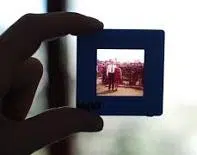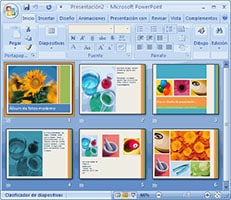 A slide is a photograph that is created on a transparent material . This is a positive print , presenting real colors, developed using a photochemical procedure.
A slide is a photograph that is created on a transparent material . This is a positive print , presenting real colors, developed using a photochemical procedure.
Traditional slides were obtained by cutting out the frames of a film. These cutouts were then framed in cardboard or plastic to facilitate storage and projection. In addition to standing out for their sharpness, these prints made on transparent media were valued for their resistance to the passage of time : a slide does not usually lose its colors, unlike what happens with photos printed in color.
A film is an old still image format , which teachers used to use in primary and secondary schools until the videocassette became popular in the 1980s, as it was less expensive and offered more features. Something similar happened when DVD and then Blu-ray came onto the market.
Between the 1940s and 1980s, with film film it was easy and economically inexpensive to broadcast films for educational purposes recorded in 16 millimeters , since it did not require much storage space and offered a high speed of rewinding , a mandatory action to replay. use them. As if these features were not attractive enough, they were very resistant to shocks and therefore did not require constant maintenance work. In fact, even today there are those who continue to use them.
The first slide projecting machines consisted of a mechanism that allowed the transparency to be extracted from a lateral sector so that the next slide could be inserted. Then projectors emerged that use discs capable of reproducing numerous slides automatically.
Regarding its history, we must go back to the beginning of the 20th century, when the technique called Autochrome appeared, which made it possible to obtain color slides through the reproduction of an additive synthesis . Two of its disadvantages with respect to the current characteristics of the slide were its poor definition and its limited chromatic resolution.
Later, the technique known as Kodachrome came onto the market, which did offer vibrant colors thanks to the use of subtractive synthesis and the application of three emulsions , so that almost the entire chromatic spectrum was covered. In 1935, it was the technique used for 8 and 16 millimeter tapes and for 35 millimeter slides.
At the beginning of the 1940s, it had achieved great popularity, but certain color defects and its poor durability made it necessary to create new techniques , and thus Ektachrome and Fujichrome emerged, which for many years made it possible to document trips and events that would be immortalized. .
 Color printed photography managed to displace the slide in certain areas, especially in the domestic sphere, although in many professional fields it remained the preferred format, as mentioned above. The advantages of digital storage , on the other hand, make any physical media seem inconvenient.
Color printed photography managed to displace the slide in certain areas, especially in the domestic sphere, although in many professional fields it remained the preferred format, as mentioned above. The advantages of digital storage , on the other hand, make any physical media seem inconvenient.
Currently, the idea of slide is usually used to name each of the images that are part of a presentation created with software . Programs such as Microsoft PowerPoint allow you to develop presentations with multiple slides, which can include photographs, graphics, text, animations and other content.
A writer giving a lecture with tips for creating a novel, for example, can support his dissertation by presenting a presentation assembled with a computer program. The author, with the help of a computer and a giant screen, can show the different slides with his suggestions.
“Slides” , finally, is the title of an album that the Argentine singer and guitarist JAF presented in 1990 . Thanks to its sales, this album became a Gold Record .
